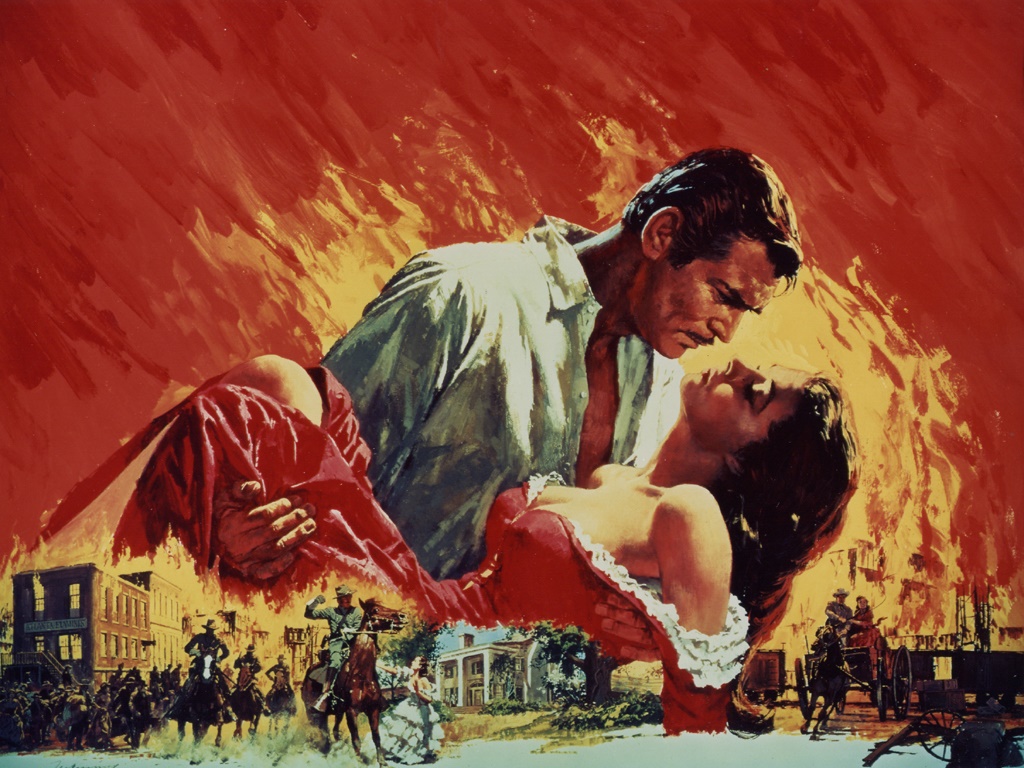On 4 July 1776, the United States was born, declaring its independence and freedom from British rule. One complete Uranus cycle later, on 12 April 1861 at 4:30 am, the first shots of what would be a long and bloody battle rang out in the spring air at Fort Sumter, North Carolina. The Civil War–and the ugliest chapter of American history– had begun. Standing as one of the central issues of this terrible war was slavery. By the time the war had ended, Abraham Lincoln and some 630,000 American soldiers were dead, the highest number of casualities killed in any war in US History.
It is on this grim war and its survivors that Margaret Mitchell based her best-selling, Pulitzer Prize winning novel, Gone With the Wind (published in 1936). Set in the pre-war Old South, Mitchell writes about the fictional life of one of literature’s and the silver screen’s most memorable heroines, Scarlett O’Hara. Scarlett was a sixteen year-old girl living on her father’s plantation when the war broke out. The 1000- page plus, doorstopper of a novel chronicles her life as she struggled not only for her own survival but also for that of her family and other household members (slaves) as they fought off Yankees. Running parallel to this storyline is Scarlett’s rather tumultuous love life (she was married three times) and most famously, the love triangle between Scarlett, Ashley Wilkes and the dashing Captain Rhett Butler.
“If the novel has a theme it is that of survival,” said Mitchell when Gone With the Wind was published. “What makes some people able to come through catastrophes and others, apparently just as able, strong and brave, go under? It happens in every upheaval. Some people survive; others don’t. What qualities are in those who fight their way through triumphantly that are lacking in those who go under… ? I only know that the survivors used to call that quality ‘gumption.’ So I wrote about the people who had gumption and the people who didn’t.”
It is interesting that Mitchell based her blockbuster on the losers of the Civil War, the Southern Confederates rather than the popular winners, the Northern Yankees. But then, as we shall see, Margaret Mitchell was no ordinary woman. Even more interesting is the divided opinion that the book and subsequent movie provokes: is Gone With the Wind one of the greatest love stories of all time or is it the most racist book–with its southern sympathies and portrayal of simple, happy slaves–ever published?
Perhaps for this reason, avid readers have failed to notice that Gone With the Wind is, as Neil Spencer describes: “a thinly disguised astrological allegory. Margaret Mitchell based the characters of her torrid epic on the zodiac, leaving a blatant trail of clues which were only picked up in 1978 when US astrologer Darrell Martinie was shown photocopies of notes from Mitchell’s library.”
Mitchell, using the Civil War as a backdrop, displayed these strong, memorable characters in a potent zodiacal parade that is led, appropriately enough, by the feisty, fiercely independent heroine, Scarlett O’Hara whose determination and energy personifies the sign of Aries.
Mitchell is careful not to beat the reader over the head with astrology and, given the extremes of people’s reaction to astrology, perhaps this is wise. But one first becomes suspicious of her inspiration in the opening pages when one of the Tarleton twins blurts out the gossip, in what could only be true Gemini style, of the engagement of Melanie Hamilton to Ashley Wilkes. Of course, the twins could not possibly know that this news would devastate Scarlett and would affect the central characters almost as much as the war itself (Mitchell had Pluto in Gemini). One thereby can also appreciate the name of Ashley Wilkes’ plantation: Twelve Oaks.
Then there is Scarlett’s land-loving, farm owning, stubborn father, a rather obvious Taurean, who in perfect synastry (as far as star signs are concerned), is married to social do-gooder, Ellen, a very helpful and efficient Virgo. Cancerian Melanie, small of bust and who dies following a miscarriage, is the wife of Scarlett’s true love, Ashley Wilkes whose love of classics and preoccupation with promotion and honour could only be the stereotype of Capricorn. And the star of the show (as he would like to think) is a very dapper Rhett Butler who manages, as a Leo, to get everyone’s attention wherever he goes.
Rounding out the zodiac is Mammy, big, powerful, and controlling and yes, black, representing the sign of Scorpio. Poor Sue Ellen, who waited patiently to be married to Mr Kennedy is the Libran who lost her man to her own sister, the scheming Scarlett. Frank Kennedy, Scarlett’s second husband, whose connections to dubious political organisations refer to Aquarian interests. Dr. Meade, a selfless doctor, Scarlett’s youngest sister, Carreen, as well as Scarlett’s first husband are self-sacrificing Piceans.
There were a few reckless, horse-loving folk but the most prominent was the progeny of Rhett and Scarlett, Bonnie Blue, who was thrown from a horse and died whilst attempting the stunt of jumping a fence on her steed. A true Sagittarian to the end, little Bonnie Blue, with her parents, completed the element of fire.
Spencer had stated that Aunt Pitty Pat and Prissy were “twittering Geminis”. Prissy, a slave who bragged she knew everything about birthing babies and then confessed she “don’t know nothing about birthing babies,” when Melanie went into a difficult labour (leaving the young Scarlett to deliver the baby) displayed the duplicity of the heavenly twins. However, Aunt Pitty Pat whose watery eyes, little feet and fondness for drink–for medicinal purposes, of course–could only belong to an archetypal Pisces.
Mitchell was born at 2:12 am on 8 November 1900 in a segregated Atlanta. Her fascination with the American Civil War can be seen with her moon’s close conjunction with Mars (6 degrees of Gemini) in the war chart. That she grew up surrounded by war veterans all willing to tell their tales is demonstrated by this conjunction occurring in the third house of the war chart, in the sign of Gemini. Mitchell’s sun at 15 degrees Scorpio opposite to the war’s moon at 15 degrees Taurus gives an indication she might find it difficult to identify with the common feelings of the war and take to the opinion of the other side. She had grown up with the glorious stories of the Old South and was stunned when she eventually learned the south had lost the war. Chiron conjunct the IC shows how she may have used the energy of the wounded healer to write about her defeated Atlanta. Perhaps most telling is the war’s Uranus opposing Mitchell’s Jupiter-Uranus conjunction. Also noticeable are the squared Neptunes, perhaps further captivating Mitchell’s imagination as well as the public’s, whose interest and buying-power would eventually boost the book’s sales to the stratosphere in post-war gloom.
Mitchell’s desire to write can be seen with a concentration of planets in the third-ninth house axis. With a third house Mercury, Jupiter and Uranus stellium in Sagittarius it seems a little talking went a long way–or perhaps a lot of talking went a little way.
. “..she (Mitchell) would get up in the middle of the night and write things. She was always obsessed with expressing herself.”
However one looks at it, the presence of a Uranus and Jupiter conjunction would make none of her manner of communicating boring or predictable (and it’s easy to see how Mitchell would have been interested in Astrology). This conjunction created a veritable hot spot in her chart and its activation by transiting and progressed planets featured in many events in her life. By her first Jupiter return, Mitchell had begun dressing as a boy and demanding that people call her “Jimmy.” By her second Jupiter return, the stage was set for her to begin writing her epic novel. And by it’s third return the book had been accepted for publication.
The third house stellium is opposed by Mitchell’s ninth house moon in Gemini (the Gauquelins found a correlation between ninth house moons and writing as a profession). The Moon opposite Mercury shows an argumentative nature, a fact certainly confirmed by members of Atlanta’s Debutante society who were scandalised by Mitchell’s suggestions for the distribution of money raised for charity and then outraged as Mitchell performed a provocative Apache war dance with a male student at one of their social balls. Far too free spirited for the likes of Atlanta’s debutantes, Mitchell abandoned this scene and became a chain-smoking, whiskey-chugging, jazz-loving flapper and danced “the Charleston” wherever, whenever and with whomever she liked.
Mitchell’s Moon also opposed Uranus, again showing emotional stress but this stress manifests through complicated or unusual romances. In her late teens, Mitchell became engaged to a man who was almost certainly homosexual and would have married him had he not been killed in the First World War. This would be the man on whom Mitchell loosely based the character of Ashley Wilkes.
In 1922 as both Saturn and the progressed ASC passed over her natal Venus, Mitchell became involved in a love triangle not unlike the one she would eventually write so memorably about. She eventually married the wrong man, divorced him, and went on to marry the other man all within the space of a few years. And at a time when divorce was not only discouraged but positively frowned upon. Her progressed Sun passed over her Mercury (opposite the moon natally) and her progressed Moon had been visited by a transiting Uranus in the seventh house. As an aside, it is interesting to note that although Mitchell dedicated her novel to JRM, the initials of her second husband, the initials RKB appear on Rhett Butler’s handkerchief and they are the transposed initials of her first husband, Red Berrien Kinnard Upshaw.
.
During her first marriage, Mitchell began working as a reporter at the Atlanta Journal Magazine, becoming one of the first women to cover hard news for that magazine. But shortly after her second marriage, she had to leave this job because of arthritis in her ankles and feet. Forced to spend most of her time in bed, she used this time to read, leading her husband to joke by saying she would have to write the kind of book she would like to read.
And so, in 1926 and through to 1929, as her progressed sun made its connections to her natal Jupiter and Uranus, Mitchell worked on Gone With the Wind. In between bouts of illness and injury, Mitchell had completed the bulk of, what she was describing to only two of her friends, as “the Great American novel”.
In 1926, the progressed lunar phase was Gibbous, indicating any hard work she invested into her novel would soon bear fruit. By 1929, when the bulk of her novel was completed, the progressed lunar phase was full and this progressed moon was approaching her natal Pluto and MC. Mitchell was truly seeing the fruits of her labour and her progressed sun on lucky Jupiter would have stoked the fire of her writing aspirations. Pluto’s presence showed how much the novel would change her life. To top it all off, it was her Saturn return.
The novel bubbled and brewed. In 1935, Harold Latham of Macmillan Publishing was in search of new writers. A friend asked Mitchell to show Latham around Atlanta and during his visit she mentioned her novel-but she refused to let him see it. After, an acquaintance cattily remarked to her that she is “not serious enough” to be a writer, a furious Mitchell gave in, gathered up her tattered manuscript and drove it to Latham and said: “take the damn thing before I change my mind”. The manuscript spellbound Latham and on 1 August 1935, Mitchell signed the contract with MacMillen publishers as a transiting Jupiter passed her natal sun..
As transiting Jupiter again activated her natal Mercury, Mitchell was putting the finishing touches on her novel. She completed the final revision on 22 January 1936, just in time for her Jupiter return. The book was published on 15 May 1936 and two days later–before the book was made available for sale to the general public–Hollywood producer David O. Selznick bought the film rights for the manuscript for $50,000, top dollar at the time. The book hit the shops on 30 June 1936 and by October that year had sold one million copies. The book had so changed her life that not only was Mitchell besieged by letters but she was unable to use public changing rooms because people kept opening the curtains to see what the now famous author looked like. In 1937, Mitchell won the Pulitzer Prize for her best selling book, just as the P. Sun contacted her IC. Mitchell had matured and quieted much by then and had long since left her flapper days behind. But whether she liked it or not, she was catapulted into fame.
With her progressed Lunar phase approaching Balsamic, Mitchell’s energy was winding down but her progressed Sun connected to Chiron in 1939. Mitchell, who had not actively sought fame, was about to have her private pain, her feelings and reflections for the Old South in the spotlight. The film would become the biggest selling movie of all time and it would defeat movies of that year such as The Wizard of Oz, Mr. Smith Goes to Washington and Good-bye Mr Chips at the Academy Awards.
With Neptune hovering over her ASC, Mitchell could hear the theme tune from Gone With the Wind for the first time along with the cast and other influential people on 15 December 1939. Atlanta rolled out the red carpet for the movie’s premiere at Loew’s Grand Theatre–for the white actors and actresses only. The Black actors, who included the Jazz singer Hattie McDaniel (“Mammy”) and Butterfly McQueen (“Prissy”) were subjected to the ludicrous segregation laws of the time.
“… Selznick learned that southerners were second to none in their affection of Negroes ‘in what they regard as their proper place’. Atlantans would warmly receive Hattie McDaniel and Oscar Polk (“Pork”) and the other actors–but they would not dine with them, invite them to their Junior League Ball in honour of the other Hollywood visitors or sit with them in an auditorium. And since the Grande Theatre was a white’s only theatre, McDaniel and the other black “guests” would have no dressing rooms, no proper place to enter and exit the theatre and no proper place to use the bathroom.”
If there is a small consolation then it must be that a young Martin Luther King sang in the boys choir as part of the evening’s entertainment–and Hattie McDaniel went on to win Best Supporting Actress at the Academy Awards, defeating the popular Olivia DeHavilland (“Melanie Wilkes”).
After the movie, with her progressed lunar phase now firmly Balsamic, Mitchell essentially rested on her laurels and wrote no more. She devoted her time to raising funds for the Red Cross and was also the anonymous benefactor of many college students. On 11 August 1949, Margaret Mitchell, who had been plagued by injury and illness throughout her life, was crossing a street near her home and was struck by a speeding taxi. She died of internal injuries several days later.
Alex Trenoweth, author of “Growing Pains” is a highly qualified astrologer and practicing secondary school teacher. She uses the tools of astrology in every day classroom management to motivate and interest adolescents in the subjects of History, Religious Education and Geography. In addition to her very busy professional life, she is also a musician and writer of fiction.



